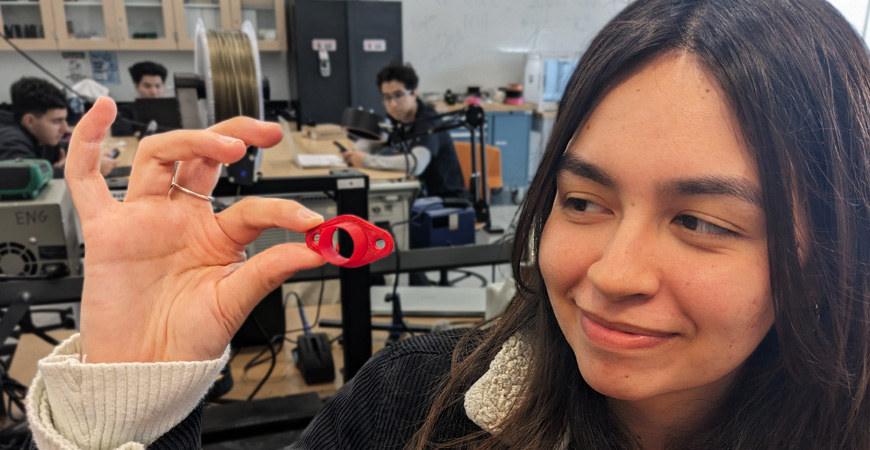
It was a terrible trifecta: a busted tilt skillet, an obsolete replacement part and thousands of hungry students restarting classes in six days.
For a UC Merced Dining Services team facing a logistical kitchen nightmare, the solution was a savory mix of collaboration and outside-the-pizza-box thinking. And it happened barely 12 giant steps from the broken cooker in the Pavilion dining center.
The replacement part — a plastic bushing for a door handle — was fabricated on a 3D printer in the School of Engineering’s Makerspace lab. It is believed to be the first time the technique, also known as additive manufacturing, was used to replace a machine part at a UC Merced facility.
A 3D printer creates by squirting out layer upon layer of melted material, following a digital blueprint of the desired shape. It’s machining by addition instead of subtraction; by contrast, a lathe cuts away everything the target shape isn’t.
None of that was on Executive Chef Matthew Perez’s mind when he learned in January that one of the three tilt skillets at the Pavilion wouldn’t work. All he knew was that students returning from winter break would pour into UC Merced’s largest dining hall in less than a week.

“Tilt skillet” doesn’t do these machines justice. What sounds like something you would buy on QVC to make a perfect Belgian waffle is, in truth, a behemoth — a quarter-ton pressure cooker, 4 feet wide and 3 feet deep, with a 45-gallon tub that pivots on a horizontal axis. The tilt feature makes it easy to collect the prepared food in trays.
“These are vital to our operations,” Perez said in early March, standing next to the now-repaired cooker.
“We can steam, grill or deep-fry nearly everything in these,” Perez said. “We can cook a 50-pound bag of beans and get it done in about 30 minutes.”
Back in January, the kitchen staff discovered one tilt skillet’s lid wasn’t latching properly. The dining facilities team was called in. Inside the handle latch, they found the bushing, broken in two. They went online to order a replacement part but found none. The part was no longer made.
That’s when Perez pivoted to the idea of recreating the part with a 3D printer. He first turned to Sean Pamer, who handles information technology procurement for the university’s Supply Chain Center of Excellence. He knew Pamer was a 3D printing hobbyist.
“I asked him, ‘Can you do it?’ He said, ‘I can try,’” Perez said.
Oz Smith, a Dining Services maintenance mechanic, shared pictures of the broken part and a sketch he made of its dimensions. Pamer researched what was needed for a printed replacement. He had the equipment to pull it off, but the plastic it required was expensive and couldn’t be purchased quickly enough.

Time for another pivot. Pamer turned to German Gavilan, School of Engineering assistant dean. Could the university’s Makerspace do the job? Absolutely, said Gavilan, who handed the task to Makerspace instructor Salvador Diaz.
Diaz huddled with Smith and fellow maintenance mechanic Cory Avila to lock down dimensions and the best material for the part. The bushing had to withstand high heat and stress. They chose a material they had on hand called rigid TPU. Diaz said it took three or four days to perfect the 3D print, testing and measuring each iteration.
Remember: This is a classroom environment. The honor of programming and operating the printer for this apparently novel job went to student Leonela Gutierrez, a fourth-year bioengineering major.
“I didn’t know what it was at the time,” Gutierrez said. “It wasn’t until later, when they sent me a ‘thank you.’”
Perez credited Pamer for connecting the dining team to the Makerspace (which, coincidentally, is only a few yards from the Pavilion kitchen, across a breezeway in the Sustainability Research and Engineering building).
“I give Sean a world of credit on this,” Perez said. “I didn’t know (3D printing) was being done on campus, to be honest with you.” Perez also lauded Smith and Avila, who he said do amazing work keeping dining operations running.
As for Pamer, he was pleased with how it turned out. “It’s a fun part of my job,” he said, “putting campus partners together to solve a campus challenge.”

